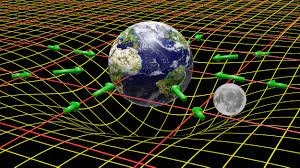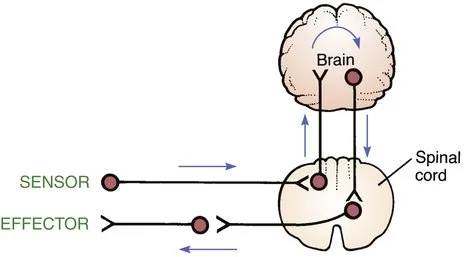A Revolutionary Way to Understand the Brain: Introducing Geometry-Informed Rehab™
This article presents a breakthrough model of the brain and nervous system — built on neural tuning, internal geometry, and dynamic trajectories — and the world’s first clinical framework to apply it: Geometry-Informed Rehab™.
Part 1: From Black Holes to Brainwaves
Not long ago, I was reading a book by British physicists Brian Cox and Jeff Forshaw about black holes. In the opening chapters, they were describing concepts such as gravity and spacetime (the fundamental structure of the universe), through the lens of Einstein’s theory of general relativity.
Historically, we’ve been taught that gravity is a ‘force’ in and of itself that exerts its pull upon us. In modern physics however, gravity is no longer described as an independent phenomenon. Instead, relativity theory tells us that gravity is simply an effect of curves in the geometry of spacetime (the structure of the universe) in response to mass, such as a planet or a star.
That insight challenged centuries of assumptions, and it got me wondering: what if our brains work in the same way? Just as gravity is not a force, but the result of curved geometry, could movement, pain, and other outputs of the nervous system be emergent properties of warped internal neural landscapes? As opposed to the teachings of traditional neuroscience which claim that outputs arise from specific neurons or groups of neurons in response to stimuli.
Our bodies and brains are just parts of the universe - so why wouldn’t they follow the same rules?
Part 2: The Traditional Model — and Its Limits
For years, we’ve been taught to think about the nervous system in terms of a "feedback loop": sensory input goes up to the brain (afference), gets processed, and motor outputs come out (efference).
This model was underpinned by the ‘neuron doctrine’, pioneered by figures such as Santiago Ramón y Cajal and Charles Sherrington, which teaches that the nervous system is made up of discrete individual neurons that communicate via synapses. This doctrine emphasised individual neurons as the fundamental units of computation and behavior. They were seen as the building blocks of thought, sensation, and movement, where firing of specific neurons was believed to correspond directly to specific outputs (e.g. motor neurons firing → muscles contract). This laid the biological groundwork for later models.
In the mid-20th century, influenced by early computing, cybernetics, and systems theory, the ‘Input-Processing-Output’ model started to view the brain as a central processing unit (CPU): taking in sensory inputs, processing them centrally, and producing motor outputs.
This feedback loop model entered rehabilitative medicine in the 1950’s-70’s, and from the 1980’s-present has become the dominant explanation in physiotherapy education. It's neat. It's tidy. It's linear - and therefore was widely adopted into clinical practice.
But that’s the problem. Modern physics tells us that the universe isn’t neat, tidy and linear, so why would our brains be?
Part 3: A New Model Emerges — Geometry-Informed Rehab (GIR)
The breakthrough occurred when I read "The Dynamics and Geometry of Choice in the Premotor Cortex" by Genkin et al., 2025. It showed that decision-making wasn't just about which neurons were firing, but about how the activity of entire populations of neurons at any one time created a ‘high-dimensional landscape’ - called a representational geometry - inside the brain. Movement and choice, it argued, were a result of the brain’s journey through this geometry.
As I drew parallels between this line of thinking and my own ideas inspired by physics, I was projected down a rabbit hole, coming across other seminal papers such as “Neural tuning and Representational Geometry” (Kriegeskorte and Wei, 2021), “Neural Manifolds for the Control of Movement” (Gallego et al., 2017), and “Towards the neural population doctrine” (Saxena and Cunningham, 2019).
The picture started to become clear. Neuroscience is currently undergoing a monumental shift in its understanding of how the brain works, which I’ve distilled down into 3 key layers:
Layer 1: Neural Tuning & Activity Neurons are ‘tuned’ (selectively responsive) to specific stimuli. When that stimulus or intention arises, the neurons tuned to it become more excitable - often exhibiting subthreshold activity - which prepares them for potential recruitment into output-generating patterns.
Layer 2: Representational Geometry The population activity of these tuned neurons forms a unique ‘shape’ in neural space - a high-dimensional landscape known as the brain’s representational geometry. This shape defines the potential options available to the system - the ‘space of possibilities’ - outlining all the potential ways the brain could respond in that moment.
Layer 3: Neural Trajectories To produce an output such as a movement, a decision, or a sensation, the brain selects a path through this space of possibilities. That path is called a neural trajectory: a coordinated pattern of population activity over time. It’s not about which neurons are firing, but about the pattern created as the brain dynamically moves through this representational geometry.
Bonus Layer 4: Neuromodulators Although neurons form the core of internal geometry, factors like glial cells, autonomic state, and the gut-brain axis modulate how these neural landscapes are created, maintained, and navigated - shaping what geometries and trajectories can emerge.
Let’s put this in the context of movement to aid understanding:
If the neural geometry is well formed, and the brain’s trajectory through it is stable, the movement is smooth, fast and efficient. But if the geometry is poorly formed due to hindered neural tuning and activation, or the trajectory your brain chooses is inefficient, or perhaps both, the result is poor movement (and in some cases no movement at all, in something like MND for example).
Put simply: movement is a journey through the brain, not a single point in it™.
This new understanding provided the conceptual framework for a completely new way of thinking about and approaching rehab - something I’m calling the ‘GIR’ model: Geometry-Informed Rehab.
Part 4: Theory into Practice — NeuralLandscape Therapy (NLT)™
Suddenly, the lens through which I viewed rehab changed completely. It stopped being about building physical capacity, improving movement patterns, or reconnecting neural pathways. Those are all important methods and tools, but the principle behind why we apply them became about affecting the brain’s internal geometries and trajectories in order to produce more desirable outputs. This is the essence of GIR.
But how do we do that?
In order to become a clinically useful model, there needs to be a clearly defined system that details how to translate the 4-layer conceptual framework into practice. After reverse engineering what it would mean to target that framework from a rehab perspective, I deduced 3-pillars of practice for GIR:
Neural Construction: Influencing neural tuning and activity to shape better internal geometries.
Neural Navigation: Improving how the brain moves through those geometries to generate more effective outputs.
Neural Modulation: Targeting broader influences like glial cell function, the gut-brain axis, and autonomic regulation to support the construction and navigation of this geometry.
And thus NeuralLandscape Therapy (NLT) - the practical application arm of the GIR model - was born. A 3-tiered approach to rehab, informed by neuroscience’s new and emerging understanding of how the brain works.
This isn’t just another methodology, it’s a complete paradigm shift in how we understand the brain, and what we do as rehabbers - whether that’s in a neurological or musculoskeletal setting.
At a fundamental level, strength exercises aren’t about building stronger muscles, they’re about helping the brain construct better neural geometries that increase movement options. Gait re-education drills aren’t about training movement patterns, they’re about helping the brain learn to navigate through its internal neural landscapes more effectively for efficient movement.
This system is already transforming the way I work with clients - from relearning how to walk after neurological injury, to resolving pain when nothing else has helped.
Part 5: The Road Ahead
Currently, there are a handful of neuroscience labs focused on neural geometry and population-level dynamics such as Krishna Shenoy’s lab (Stanford), and Mehrdad Jazayeri (MIT). These are high-level computational neuroscientists - brilliant minds, but mostly working on models of cognition, movement, and perception, not clinical translation.
This is a cutting-edge subfield that’s still maturing - but very real, with no clearly defined clinical models in the world using neural geometry and dynamic trajectories as their foundational framework currently existing - yet (although some forward-thinking practitioners are intuitively close).
We’re only just beginning to uncover how deeply geometry and population activity shape our experiences of movement, pain, and decision-making, making GIR the pioneering attempt to translate these concepts into clinical practice.
To advance as a transformative model of rehabilitation, the next step is twofold. Firstly, to continue refining the theoretical foundations of Geometry-Informed Rehab; and second, to formalise NeuralLandscape Therapy into an evidence-informed intervention system that clinicians can apply in real-world settings. This includes developing practical tools and methodologies, case studies, and training programs, while fostering research collaborations to further validate and refine the model’s core principles and techniques.
If you’re a forward-thinking practitioner, researcher, or educator and would like to hear more about GIR, or potentially contribute to its development, feel free to contact me using the email george@progressphysioclinic.co.uk - collaboration is welcomed and encouraged.
The goal is clear: to bring this paradigm from the cutting edge to the clinical frontline.
Thanks for reading. This is the first in a series of posts unpacking Geometry-Informed Rehab. Stay tuned.
Published 14/07/2025





